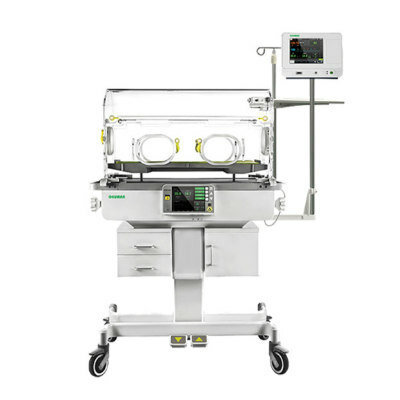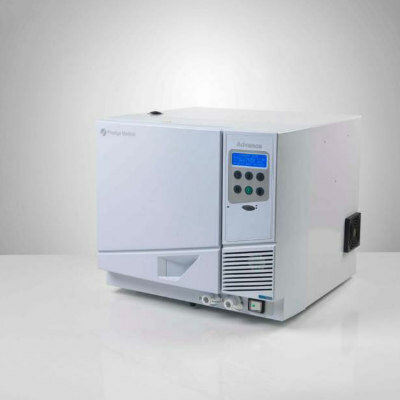New Apple Watch Includes Built-in ECG
|
By HospiMedica International staff writers Posted on 27 Sep 2018 |

Image: The new Apple Watch can take an ECG (Photo courtesy of Apple).
The latest iteration of the Apple (Cupertino, CA, USA) Watch, the Series 4, includes an electrocardiogram (ECG) sensor, officially classifying it as a medical device capable of alerting its user to abnormal heart rhythms. The new smartwatch was revealed at the recent September 2018. Apple iPhone launch event.
To obtain an ECG, users touch and hold the side of the watch while it sends an electric current through the chest to the opposite hand; after 30 seconds, the device measures heart rhythms using electrodes built into the back of the sapphire crystal and the digital crown. The sensor classifies them, alerting the user if there are signs of atrial fibrillation (AF). The watch also intermittently analyzes heartbeats in the background for irregularities, or if pulse exceeds or falls below a specified threshold. All data recordings and any noted symptoms are stored in the watch’s Health app in a PDF file format that can be shared with physicians.
Additional health features include fall detection, which works by analyzing wrist trajectory and impact acceleration. If needed, the Watch will initiate an emergency call. If it senses the user is immobile for one minute, it will automatically call and send a message to emergency contacts using the native SOS feature. Other improvements include enhanced fitness and health tracking, walkie-talkie mode, a breath feature to guide breathing for meditation, and more. An app unlocking the wrist-based ECG functionality will be available to consumers in the United States in late 2018.
“We’re thrilled Apple Watch has become an essential part of people's lives,” said Jeff Williams, chief operating officer at Apple. “The completely redesigned Apple Watch Series 4 continues to be an indispensable communication and fitness companion, and now with the addition of groundbreaking features, like fall detection and the first-ever ECG app offered directly to consumers, it also becomes an intelligent guardian for your health.”
“We’re enthused by what we see currently happening in digital health. Recent product approvals and clearances have given consumers and providers access to powerful technologies that have the potential to advance the delivery of health care,” commented FDA Commissioner Scott Gottlieb, MD. “We know that our actions will help encourage the development of incredibly innovative products. We hope to see health care adopting more and more disruptive technologies that positively impact people’s lives.”
While retaining its original design, the fourth-generation Apple Watch includes a 30% larger display, which is seamlessly integrated into a thinner, smaller case, with a new user interface that provides more information with richer detail. The Series 4 runs on watchOS 5, which provides advanced activity and communications features, a new accelerometer and gyroscope which measures up to 32 g forces, and an electrical heart rate sensor that has been granted a De Novo classification by the U.S. Food and Drug Administration (FDA) as a Class II medical device.
Related Links:
Apple
To obtain an ECG, users touch and hold the side of the watch while it sends an electric current through the chest to the opposite hand; after 30 seconds, the device measures heart rhythms using electrodes built into the back of the sapphire crystal and the digital crown. The sensor classifies them, alerting the user if there are signs of atrial fibrillation (AF). The watch also intermittently analyzes heartbeats in the background for irregularities, or if pulse exceeds or falls below a specified threshold. All data recordings and any noted symptoms are stored in the watch’s Health app in a PDF file format that can be shared with physicians.
Additional health features include fall detection, which works by analyzing wrist trajectory and impact acceleration. If needed, the Watch will initiate an emergency call. If it senses the user is immobile for one minute, it will automatically call and send a message to emergency contacts using the native SOS feature. Other improvements include enhanced fitness and health tracking, walkie-talkie mode, a breath feature to guide breathing for meditation, and more. An app unlocking the wrist-based ECG functionality will be available to consumers in the United States in late 2018.
“We’re thrilled Apple Watch has become an essential part of people's lives,” said Jeff Williams, chief operating officer at Apple. “The completely redesigned Apple Watch Series 4 continues to be an indispensable communication and fitness companion, and now with the addition of groundbreaking features, like fall detection and the first-ever ECG app offered directly to consumers, it also becomes an intelligent guardian for your health.”
“We’re enthused by what we see currently happening in digital health. Recent product approvals and clearances have given consumers and providers access to powerful technologies that have the potential to advance the delivery of health care,” commented FDA Commissioner Scott Gottlieb, MD. “We know that our actions will help encourage the development of incredibly innovative products. We hope to see health care adopting more and more disruptive technologies that positively impact people’s lives.”
While retaining its original design, the fourth-generation Apple Watch includes a 30% larger display, which is seamlessly integrated into a thinner, smaller case, with a new user interface that provides more information with richer detail. The Series 4 runs on watchOS 5, which provides advanced activity and communications features, a new accelerometer and gyroscope which measures up to 32 g forces, and an electrical heart rate sensor that has been granted a De Novo classification by the U.S. Food and Drug Administration (FDA) as a Class II medical device.
Related Links:
Apple
Latest Health IT News
- Machine Learning Model Improves Mortality Risk Prediction for Cardiac Surgery Patients
- Strategic Collaboration to Develop and Integrate Generative AI into Healthcare
- AI-Enabled Operating Rooms Solution Helps Hospitals Maximize Utilization and Unlock Capacity
- AI Predicts Pancreatic Cancer Three Years before Diagnosis from Patients’ Medical Records
- First Fully Autonomous Generative AI Personalized Medical Authorizations System Reduces Care Delay
- Electronic Health Records May Be Key to Improving Patient Care, Study Finds
- AI Trained for Specific Vocal Biomarkers Could Accurately Predict Coronary Artery Disease
- First-Ever AI Test for Early Diagnosis of Alzheimer’s to Be Expanded to Diagnosis of Parkinson’s Disease
- New Self-Learning AI-Based Algorithm Reads Electrocardiograms to Spot Unseen Signs of Heart Failure
- Autonomous Robot Performs COVID-19 Nasal Swab Tests

- Statistical Tool Predicts COVID-19 Peaks Worldwide
- Wireless-Controlled Soft Neural Implant Stimulates Brain Cells
- Tiny Polymer Stent Could Treat Pediatric Urethral Strictures
- Human Torso Simulator Helps Design Brace Innovations
- 3D Bioprinting Rebuilds the Human Heart
- Nanodrone Detects Toxic Gases in Hazardous Environments
Channels
Artificial Intelligence
view channel
AI-Powered Algorithm to Revolutionize Detection of Atrial Fibrillation
Atrial fibrillation (AFib), a condition characterized by an irregular and often rapid heart rate, is linked to increased risks of stroke and heart failure. This is because the irregular heartbeat in AFib... Read more
AI Diagnostic Tool Accurately Detects Valvular Disorders Often Missed by Doctors
Doctors generally use stethoscopes to listen for the characteristic lub-dub sounds made by heart valves opening and closing. They also listen for less prominent sounds that indicate problems with these valves.... Read moreCritical Care
view channel
Deep-Learning Model Predicts Arrhythmia 30 Minutes before Onset
Atrial fibrillation, the most common type of cardiac arrhythmia worldwide, affected approximately 59 million people in 2019. Characterized by an irregular and often rapid heart rate, atrial fibrillation... Read more
Breakthrough Technology Combines Detection and Treatment of Nerve-Related Disorders in Single Procedure
The peripheral nervous system (PNS) serves as the communication network that links the brain and spinal cord to every other part of the body. It consists of two parts: the somatic nervous system, which... Read moreSurgical Techniques
view channel
Hydrogel-Based Miniaturized Electric Generators to Power Biomedical Devices
The development of engineered devices that can harvest and convert the mechanical motion of the human body into electricity is essential for powering bioelectronic devices. This mechanoelectrical energy... Read moreWearable Technology Monitors and Analyzes Surgeons' Posture during Long Surgical Procedures
The physical strain associated with the static postures maintained by neurosurgeons during long operations can lead to fatigue and musculoskeletal problems. An objective assessment of surgical ergonomics... Read more.jpg)
Custom 3D-Printed Orthopedic Implants Transform Joint Replacement Surgery
The evolving field of 3D printing is revolutionizing orthopedics, especially for individuals requiring joint replacement surgeries where traditional implants fail to provide a solution. Although most people... Read more
Cutting-Edge Imaging Platform Detects Residual Breast Cancer Missed During Lumpectomy Surgery
Breast cancer is becoming increasingly common, with statistics indicating that 1 in 8 women will develop the disease in their lifetime. Lumpectomy remains the predominant surgical intervention for treating... Read moreHealth IT
view channel
Machine Learning Model Improves Mortality Risk Prediction for Cardiac Surgery Patients
Machine learning algorithms have been deployed to create predictive models in various medical fields, with some demonstrating improved outcomes compared to their standard-of-care counterparts.... Read more
Strategic Collaboration to Develop and Integrate Generative AI into Healthcare
Top industry experts have underscored the immediate requirement for healthcare systems and hospitals to respond to severe cost and margin pressures. Close to half of U.S. hospitals ended 2022 in the red... Read more
AI-Enabled Operating Rooms Solution Helps Hospitals Maximize Utilization and Unlock Capacity
For healthcare organizations, optimizing operating room (OR) utilization during prime time hours is a complex challenge. Surgeons and clinics face difficulties in finding available slots for booking cases,... Read more
AI Predicts Pancreatic Cancer Three Years before Diagnosis from Patients’ Medical Records
Screening for common cancers like breast, cervix, and prostate cancer relies on relatively simple and highly effective techniques, such as mammograms, Pap smears, and blood tests. These methods have revolutionized... Read morePoint of Care
view channel
Critical Bleeding Management System to Help Hospitals Further Standardize Viscoelastic Testing
Surgical procedures are often accompanied by significant blood loss and the subsequent high likelihood of the need for allogeneic blood transfusions. These transfusions, while critical, are linked to various... Read more
Point of Care HIV Test Enables Early Infection Diagnosis for Infants
Early diagnosis and initiation of treatment are crucial for the survival of infants infected with HIV (human immunodeficiency virus). Without treatment, approximately 50% of infants who acquire HIV during... Read more
Whole Blood Rapid Test Aids Assessment of Concussion at Patient's Bedside
In the United States annually, approximately five million individuals seek emergency department care for traumatic brain injuries (TBIs), yet over half of those suspecting a concussion may never get it checked.... Read more
New Generation Glucose Hospital Meter System Ensures Accurate, Interference-Free and Safe Use
A new generation glucose hospital meter system now comes with several features that make hospital glucose testing easier and more secure while continuing to offer accuracy, freedom from interference, and... Read moreBusiness
view channel
Johnson & Johnson Acquires Cardiovascular Medical Device Company Shockwave Medical
Johnson & Johnson (New Brunswick, N.J., USA) and Shockwave Medical (Santa Clara, CA, USA) have entered into a definitive agreement under which Johnson & Johnson will acquire all of Shockwave’s... Read more
















